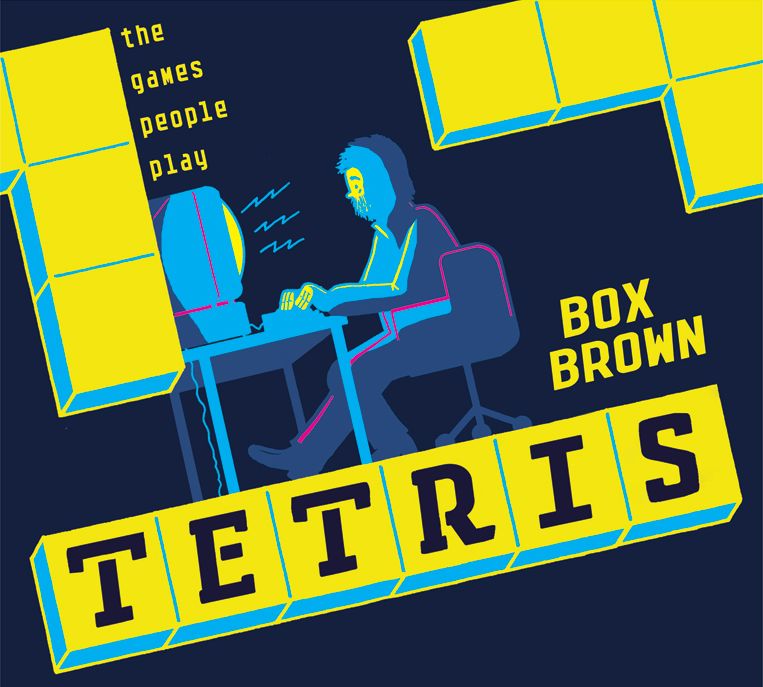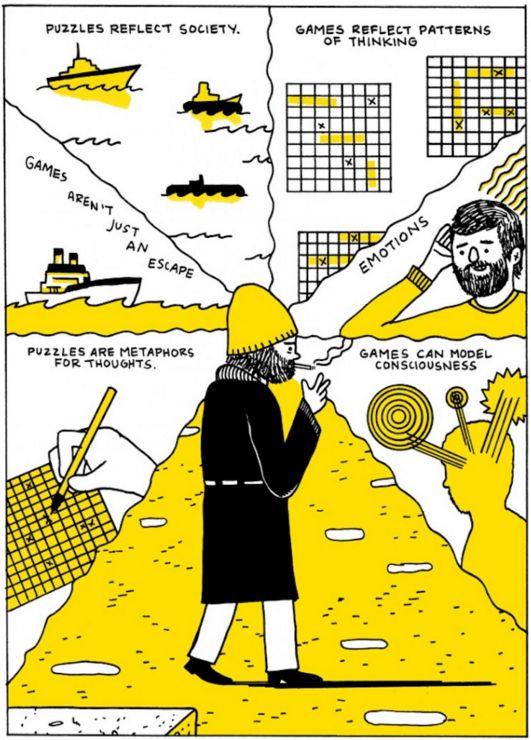 
Tetris: The Games People play
by Box Brown
Reviewed by Chris Auman

For me reading a comic about a video game is like eating an ice cream cone about a pizza: they’re both awesome things! I also strongly believe that graphic novels are the perfect format for learning, no matter what your age.
Furthermore, I believe that Box Brown is a great teacher in this respect. After all, it was he who taught the world about the gargantuan wrestling legend Andre “The Giant” Roussimoff in his 2013 biography, Andre The Giant: Life and Legend. Mr. Brown now continues his educational storytelling with Tetris: The Games People Play also from imprint First Second Books.
Brown begins his Tetris telling at the beginning of humankind when our hairy cave-dwelling ancestors invented what would eventually become recognizable as games. Brown believes that artists were first to give shape and meaning to the rudimentary games humans engaged in and he points to the Lascaux cave paintings as an example. In these works of art created 17,000 years ago in southwestern France, running, wrestling, hunting and other sports are depicted.
Fast forward about 13,500 years and the Egyptians were playing senet, which was perhaps the first board game ever. Senet was more than just a contest of simple skill and strategy, it was a metaphor for life. The depth and meaning of the gaming experience had deepened.
Brown brings us forward again to 1889 when Nintendo founder and artist Fusajiro Yamauchi started the company to sell his hand-painted playing cards. This auspicious start would, nearly a century later, give rise to a global gaming empire. All this brings us to the Soviet Union in 1984 when Alexey Pajitnov, a computer scientist at the Moscow Academy of Science, started thinking about games. Really, really thinking about them.
Pajitnov looked at the concept of games from a philosophical perspective and his deep thinking on the subject gave birth to his computer game, Tetris.
Tetris, in case you have been living under a rock on the moon for the past thirty years, is a tile matching puzzle game. As the differently shaped pieces drop from the top of the screen, they are maneuvered by the player to create a series of horizontal lines at the bottom of the screen. Once a line is completed, it disappears. Nearly every gaming system on the planet has a version of the game and Tetris is currently closing in on 200 million copies sold in both physical and digital formats. All that would come later, however.

Before the Tetris revolution began worldwide, Alexey and his coworkers passed around his game on floppy disks. It would have been illegal to sell it so that possibility wasn’t considered. When copies of the game began circulating outside of the Soviet Union, the capitalists came sniffing and eventually the Soviets caught wind of the game and its origin.
In the mid 1980s, a company named ELORG (the acronym for something even more bland sounding) was created by the Soviets to handle the rights and the exporting of Tetris. Brown covers the very convoluted negotiating process between several key players in the video game hardware and software industries. In the pre-email and Internet days, this required much faxing and waiting and early morning phone calls and long flights to the USSR where stern Soviet bureaucrats sat at the other end of the bargaining table.
The Tetris pie would get sliced up considerably with a mere fraction going to the creator, and only after he emigrated from the USSR to the US in the early 90s. Before that happened, coin op machines, computer systems, console games and especially the popular Nintendo Game Boy version had made Tetris addicts out of many across the globe, young and old.
Box Brown lays this all out for us in glorious black, white and yellow. His concise storytelling and simple line art keep things moving and compelling and gives the players in the story just enough personality to inspire either empathy or disdain depending on their actions and motives. It’s also a story of what happens when art and commerce collide because yes, video games are an art form.
READ: An interview with Box Brown
PLAY: Tetris |